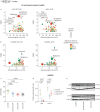Nicotine promotes e-cigarette vapour-induced lung inflammation and structural alterations
- PMID: 37105573
- PMCID: PMC10285110
- DOI: 10.1183/13993003.00951-2022
Nicotine promotes e-cigarette vapour-induced lung inflammation and structural alterations
Abstract
Background: Electronic cigarette (e-cigarette) vapour is gaining popularity as an alternative to tobacco smoking and can induce acute lung injury. However, the specific role of nicotine in e-cigarette vapour and its long-term effects on the airways, lung parenchyma and vasculature remain unclear.
Results: In vitro exposure to nicotine-containing e-cigarette vapour extract (ECVE) or to nicotine-free e-cigarette vapour extract (NF ECVE) induced changes in gene expression of epithelial cells and pulmonary arterial smooth muscle cells (PASMCs), but ECVE in particular caused functional alterations (e.g. a decrease in human and mouse PASMC proliferation by 29.3±5.3% and 44.3±8.4%, respectively). Additionally, acute inhalation of nicotine-containing e-cigarette vapour (ECV) but not nicotine-free e-cigarette vapour (NF ECV) increased pulmonary endothelial permeability in isolated lungs. Long-term in vivo exposure of mice to ECV for 8 months significantly increased the number of inflammatory cells, in particular lymphocytes, compared to control and NF ECV in the bronchoalveolar fluid (BALF) (ECV: 853.4±150.8 cells·mL-1; control: 37.0±21.1 cells·mL-1; NF ECV: 198.6±94.9 cells·mL-1) and in lung tissue (ECV: 25.7±3.3 cells·mm-3; control: 4.8±1.1 cells·mm-3; NF ECV: 14.1±2.2 cells·mm-3). BALF cytokines were predominantly increased by ECV. Moreover, ECV caused significant changes in lung structure and function (e.g. increase in airspace by 17.5±1.4% compared to control), similar to mild tobacco smoke-induced alterations, which also could be detected in the NF ECV group, albeit to a lesser degree. In contrast, the pulmonary vasculature was not significantly affected by ECV or NF ECV.
Conclusions: NF ECV components induce cell type-specific effects and mild pulmonary alterations, while inclusion of nicotine induces significant endothelial damage, inflammation and parenchymal alterations.
Copyright ©The authors 2023.
Conflict of interest statement
Conflict of interest: All authors have nothing to disclose.
Figures






Comment in
-
(V)aperçu on the harm of nicotine e-cigarettes.Eur Respir J. 2023 Jun 22;61(6):2300886. doi: 10.1183/13993003.00886-2023. Print 2023 Jun. Eur Respir J. 2023. PMID: 37348900 No abstract available.
References
Publication types
MeSH terms
Substances
LinkOut - more resources
Full Text Sources
Medical
